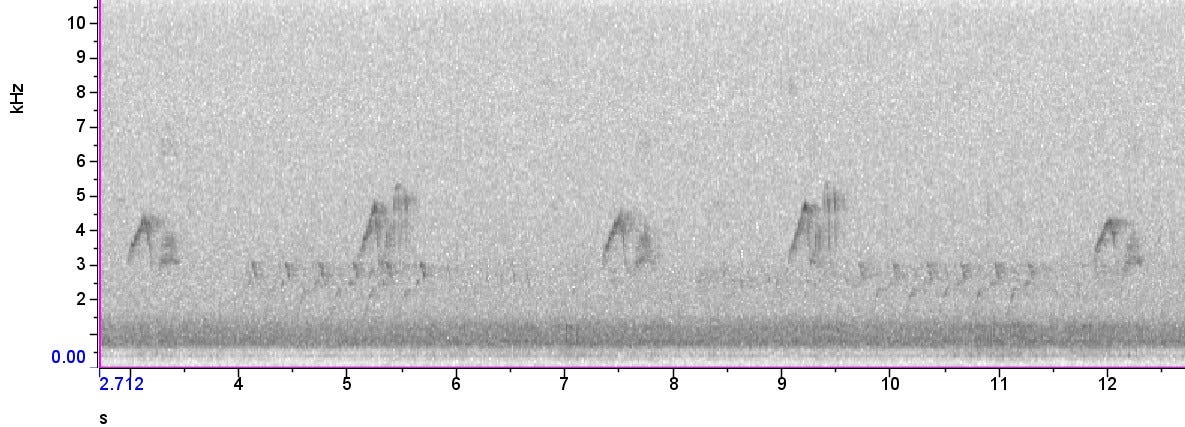
The dawn is getting longer quickly: American Robins are at it before five while the Song Sparrow starts earlier every day. Today it sings at 6:35, followed minutes later by a faint Eastern Phoebe over by the Pennsylvania Avenue bridge hidden behind the buildings to my right. Then the Northern Cardinal: call at 6:43, song by 6:47, and the junkyard raven joins in with a honk. A Carolina Wren ‘teakettles’ loudly over by the confluence, and something shrieks, like a squirrel.
The Noisy Ones
Whatever else starting up before seven is blotted out by a five-minute long train which must have 300 cars. After that the dawn is muted, and by 7:09 there’s nothing in the air, while the noisy ones down below go on and on and on (they haven’t stopped since their first songs): phoebe, robins, Carolina Wren, Song Sparrow. Quite a contrast from the previous two days’ clear skies, which at this time were crisscrossed by dawn-flying birds.
Finally, at 7:14, some robins head east overhead, followed by an American Crow and just two Red-winged Blackbirds.
These days, the European Starlings, like the Common Grackles, mostly issue from the west and stake out their dawn posts in the two favorite trees, as every day: poplar at my 10:30, sycamore at 1:30, the two tallest trees in the vicinity and right next to the interstate. Both species are active and courting, and it won’t be long until they’re well on their way to their first broods of 2023.
Rain of Grackles
Dave had sent me a link to 4-minute video of an icterine swarm he came across yesterday around 12:45 PM up on Sapsucker Ridge. It appeared to be mostly Common Grackles, some 3,000 spread out over about 1,000 feet of ridgetop, flying repeatedly from the trees onto the ground. He was not sure what they were looking for, but it could be they were after birch seeds or whatever else is left to eat. After some 45 minutes, the great flock headed southwest along the Sinking Valley side of the mountain.
This mass of grackles and others represents the largest single number of birds recorded at one time on the hotspot!
This morning, at 7:23 AM, a mere 350 pass overhead from the south—maybe part of that same flock—heading north. Another 33 go over seconds later, and more that settle in local trees swell the daily total here in town to over 400.
A pair of Ring-billed Gulls shows up, flying low, east to west. Right around 7:25, I detect a distinct morning apex, what I call the minute or so in time that the maximum number of birds and species are in the air at the same time. After that, things die down quickly, and three robins come to chase and yell at each other in the parking lot.
A Black Vulture heads east at 7:39, though oddly, no Turkey Vultures have appeared yet. This one may be the self-same individual Mom and Dave watched on the road below the house a couple evenings ago; there seems to be a single as well as a pair in the area.
Four amorous House Finches chase each other repeatedly across the sky, from north to south and back. And for the first time this year, I hear the local Downy Woodpecker drumming; as usual, it’s the species that signals the end of another dawn vigil.
‘If It Smells Like S*^&t in March, NFCs Will Surely Come’
I am reminded of this highly obscure old farmers’ adage while retrieving three days’ of recordings from the garage. The manure smell is from fields to the east in Sinking Valley and indicates a south or southeast wind, favorable for night-moving birds (I hope). Later, I have time to go over last night’s spectrum, but there’s not much. One new addition is a Brown Thrasher (PH200 #78), stealthily practicing its repertoire even before 6 AM.
The garage door is open now, with little worry about my gear freezing. The reason is what I’m told is a desperately frustrated phoebe. Going back generations (of phoebe), a pair has nested inside, up on the beams, and so the lineage must continue. Meanwhile, across the field somewhere, an American Crow emits its aggressive rattle call and a Red-bellied Woodpecker sounds off as well. I eschew an evening stroll up here, though, in the off chance the pond has got something good.
Hoodie!
Along the river, insects of various descriptions are out in the nearly 60-degree air. At the pond, just a single Mallard is nosing (beaking?) about in the brackish-looking scum. Nearer to me, a small form with an oddly-shaped head resolves itself a female Hooded Merganser, swimming about agitatedly. I get my camera ready but then can’t find the duck again. Deciding to move around the edge to get closer, I manage to flush it.
This brief encounter is the first-ever of this diminutive species from the pond; the only prior record in the hotspot was of one flying, from my balcony, last fall.



